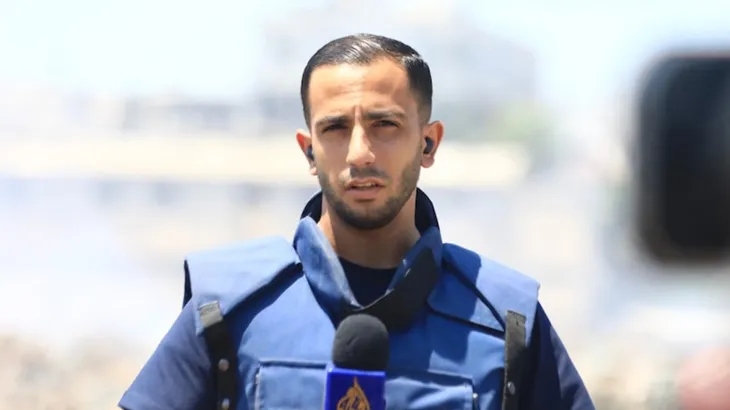
In a deeply polarizing development, Israel’s military announced on Sunday that it had killed Anas Al Sharif, a prominent Al Jazeera journalist, in an airstrike on Gaza City. The Israeli Defense Forces (IDF) claimed Al Sharif was not merely a reporter but the head of a Hamas terrorist cell responsible for orchestrating rocket attacks against Israeli civilians and troops. The strike, which targeted a tent near the gates of al-Shifa Hospital in eastern Gaza, also killed four other Al Jazeera journalists and an assistant, according to Gaza health officials and the broadcaster itself.
The incident has ignited a firestorm of condemnation from press freedom advocates, international organizations, and Al Jazeera, which vehemently denies the Israeli allegations and accuses the IDF of targeting journalists to silence critical coverage of the war in Gaza.
The Strike and Its Victims
The airstrike occurred in an area that had become a makeshift press zone outside al-Shifa Hospital, one of the few remaining operational medical facilities in Gaza. Among the dead were journalists Mohammed Qreiqeh, Ibrahim Zaher, Mohammed Noufal, and Moamen Aliwa, in addition to Al Sharif. The tent they were using was reportedly marked and known to house media personnel3.
Al Sharif, 28, was a well-known correspondent for Al Jazeera Arabic, recognized for his frontline reporting from northern Gaza. His social media presence was substantial, with over 500,000 followers on X (formerly Twitter), where he posted real-time updates on the conflict. Minutes before his death, he had documented intense Israeli bombardment in Gaza City, describing the use of “fire belts”—a tactic involving concentrated aerial strikes.
Israel’s Justification
The IDF released a statement shortly after the strike, asserting that Al Sharif was a Hamas operative who had infiltrated Al Jazeera to mask his militant activities. According to the military, intelligence gathered from seized documents in Gaza—including rosters, training records, and salary lists—proved his affiliation with Hamas. “A press badge isn’t a shield for terrorism,” the IDF declared in a social media post, accompanied by a profile of Al Sharif labeled with a target emoji.
The military further claimed that Al Sharif had played a direct role in advancing rocket attacks against Israeli targets and was therefore a legitimate military target. The IDF emphasized that the strike was “precise” and based on verified intelligence.
Al Jazeera’s Response
Al Jazeera categorically rejected the Israeli narrative, calling the strike a “desperate attempt to silence voices in anticipation of the occupation of Gaza.” The network described Al Sharif as “one of Gaza’s bravest journalists,” and said the attack was part of a broader campaign to intimidate and eliminate reporters who challenge Israel’s actions in the enclave.
In a poignant posthumous message left by Al Sharif to be published in the event of his death, he wrote: “I never hesitated to convey the truth as it is, without distortion or misrepresentation, hoping that God would witness those who remained silent.” The message has since gone viral, symbolizing the perilous conditions under which journalists operate in Gaza.
Press Freedom Advocates Push Back
The Committee to Protect Journalists (CPJ) condemned the killings and questioned the credibility of Israel’s claims. “Israel’s pattern of labeling journalists as fighters without providing credible evidence raises serious questions about its intent and respect for press freedom,” said Sara Qudah, CPJ’s director for the Middle East and North Africa.
UN Special Rapporteur Irene Khan had previously warned that Al Sharif’s life was in danger due to his reporting. She stated last month that Israel’s accusations against him were unsubstantiated and part of a broader trend of targeting journalists in conflict zones.
According to the Hamas-run Gaza media office, 237 journalists have been killed since the war began in October 2023. CPJ places the toll at at least 186, highlighting the extreme risks faced by media personnel in the region.
Political and Strategic Implications
The timing of the strike has raised concerns that it may be a prelude to a broader Israeli offensive. Hamas issued a statement warning that the assassination of journalists and the intimidation of those who remain “paves the way for a major crime that the occupation is planning to commit in Gaza City”.
Israeli Prime Minister Benjamin Netanyahu has recently signaled plans to expand military operations in Gaza, aiming to dismantle Hamas strongholds and reassert control over the territory. A controversial evacuation order has been issued, giving over a million residents until October 7 to leave Gaza City before a full-scale reoccupation begins. The UN has expressed grave concern over the plan, warning of “catastrophic consequences”.
Netanyahu has framed the strategy as a liberation effort, stating: “We intend to remove Hamas there, and to pass it to civilian governance that is not Hamas and not anyone advocating the destruction of Israel. We want to liberate ourselves and liberate the people of Gaza from the awful terror of Hamas.”
A Broader Pattern?
This is not the first time Israel has accused journalists of being militants. In October 2024, the IDF released a list of six Gaza-based journalists it alleged were affiliated with Hamas and Palestinian Islamic Jihad. Al Jazeera was quick to denounce the list, calling it fabricated and politically motivated.
The Israeli government has long had a contentious relationship with Al Jazeera, accusing the Qatar-funded network of incitement and biased coverage. In May 2024, Israel shut down Al Jazeera’s local offices, a move widely criticized by international media watchdogs.
Conclusion
The killing of Anas Al Sharif and his colleagues has once again spotlighted the perilous intersection of journalism and conflict in Gaza. While Israel maintains that the strike was a legitimate military action against a terrorist, Al Jazeera and press freedom advocates argue it was a targeted assassination aimed at silencing dissent.
As the war in Gaza continues to escalate, the role of journalists in documenting the human toll becomes ever more critical—and increasingly dangerous. Whether Al Sharif was a militant or a martyr for truth, his death underscores the high stakes of reporting from one of the world’s most volatile regions.















